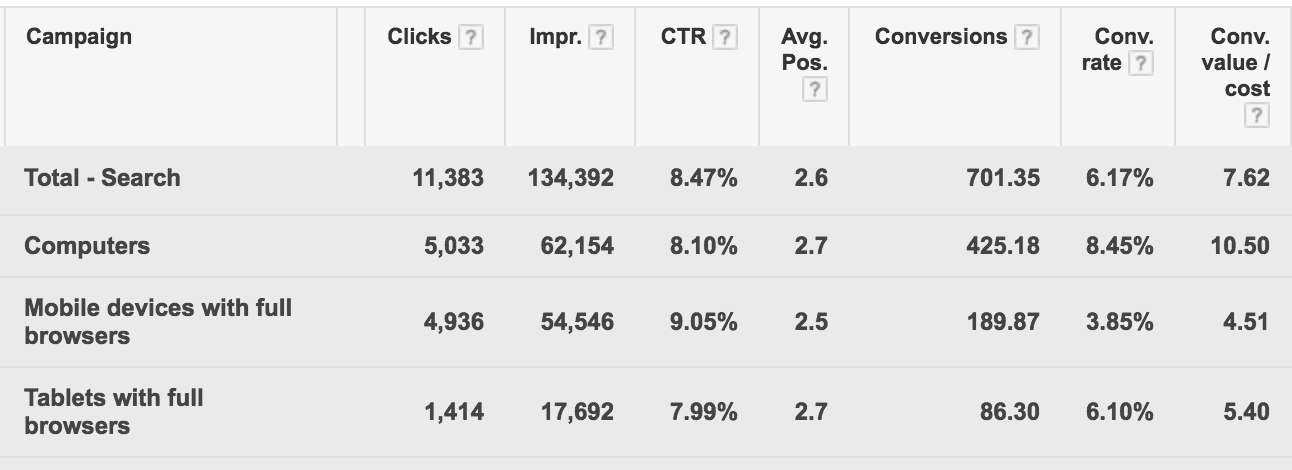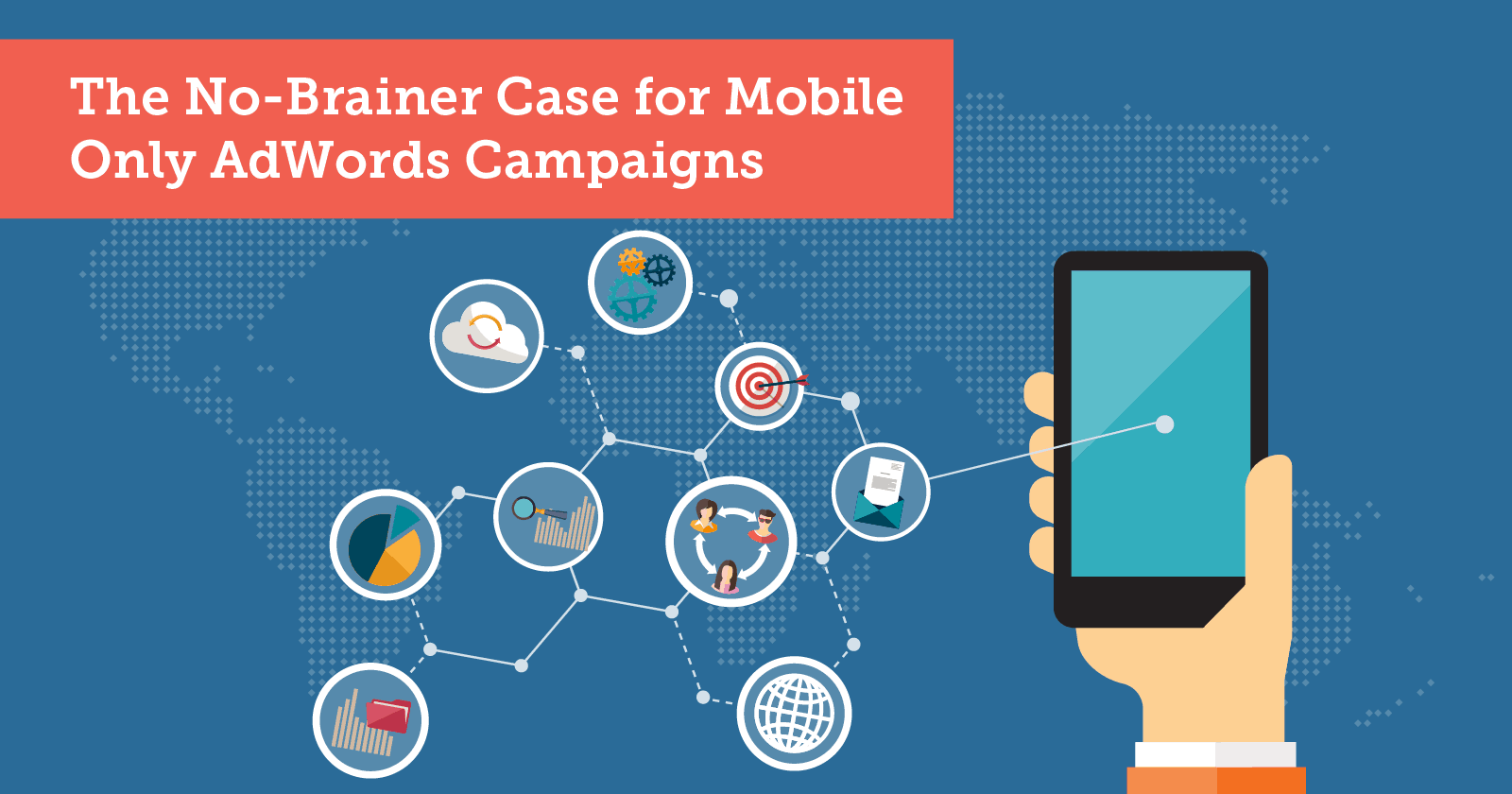Device specific campaigns are great, which raises the question: why aren’t more companies implementing such campaigns?
Let’s take a look at this issue and what some of the reasons for (and against) mobile-only and desktop-only campaigns are.
The Case for Mobile-Only Campaigns
Before we even start, then let’s take a look at a stat that happens in nearly every single AdWords account these days:

About 45 percent of all clicks come from mobile.
Just about 27 percent of conversions come from mobile.
If mobile is not active in your mind whenever you optimize your AdWords campaigns you’re missing out.
To start, let’s make it clear that I’m pretty biased: splitting campaigns is almost always the right answer – not in every campaign and not for every keyword, but for almost every company.
It’s highly unlikely that if you’re invested in high-performance AdWords campaigns that you won’t benefit from splitting at least some of your campaigns into mobile- and desktop-specific campaigns.
There are plenty of reasons for this (as I’ll continue to get into throughout this article), but the first two are the most important.
First, your bid adjustments will be different for desktop and mobile users, if for no other reason than that people use these devices at different times of the day.
The second reason is one of strategy, which is that you should want as detailed tracking as possible, which means tracking on a per-device level. This is possible in the AdWords interface, but it’s hidden and not immediately apparent what’s happening on mobile devices vs. desktop devices when they aren’t split into separate campaigns.
Why Mobile & Desktop Campaigns Don’t Perform The Same
Let’s talk for a minute about how you use your smartphone and how you use your desktop computer.
Like nearly all people, you use your devices in different ways, in different contexts, and with different goals in mind.
Your web browsing behaviors are going to be dramatically different if you’re on a train during a commute, if you’re sitting on your couch at home, or if you’re scrolling through Twitter in line at the grocery store.
In each of these environments, you’re going to be doing different things and are going to respond to different terms in different ways. It’s because of this that the terms you use can have dramatically different response rates depending on if you are targeting mobile devices or desktop devices.
The Challenges of Mobile-Only Campaigns
If mobile-only campaigns were easy, then everyone would be doing them and I wouldn’t need to write this article.
Instead, as evidenced by the existence of what you’re reading, you’ll find that there are a few common challenges that people make when arguing against mobile-only campaigns.
I’ve picked (and debunked) the two arguments against the virtues of mobile-only campaigns that I hear most often, so you’ll have an answer when someone challenges your strategy.
Challenge #1: Not Enough Data
“There just isn’t enough data coming from mobile devices to gather statistically significant insights.”
This argument is especially valid when you split your campaigns with a lower amount of search volume up into desktop and mobile devices, you’ll find that your desktop campaign loses data, while your mobile campaign isn’t as significant as your desktop campaign.
This understandably scares people away from splitting their campaigns, as losing statistical significance means not having the confidence to invest (or call of an investment in) different campaigns.
However, the counter-argument is clear: if you don’t have statistical significance in your device-specific campaigns, then there’s a good chance you never had statistical significance in the first place. If anything, it’s better to know that you don’t have statistical significance than to pretend that you have it, while never reaching it in the first place.
Challenge #2: It’s Time Consuming
“Setting up an entirely second set of campaigns targeting only mobile devices is a lot of work.”
This challenge is less easily debunked. Yes, it’s true that if you split up your campaigns into mobile and desktop (or even into the types of mobile devices, tablets, desktop computers, and other device-level variables), you’re going to have duplicate work.
However, my answer to this is simple: only do it when you can get a reward from it.
Once you create the basic layer of the campaign, you can just duplicate it, change the device targeting, and update your bid settings. It isn’t automatic, but it helps eliminate the excuse that mobile-only campaigns take too much time.
The really time consuming part comes afterwards – the optimization. But if you’re achieving improved performance, then the return on your time is well worth it.
When You Should Run a Separate Mobile-Only Campaign
Knowing when to split up your campaigns by device is half the battle.
There are four situations that you should be aware of when deciding whether to run a mobile-only campaign. These aren’t the only situations, but they are the ones that are common enough that you’ll find them in most mature AdWords accounts.
Situation #1: Your Performance Difference Is Substantial
As I mentioned in the section on user behavior preferences, there is a difference between how people act on mobile and on desktop devices. Unsurprisingly, this has an impact on the conversion rates for AdWords ads.
This then leads to my first situation for when you should run mobile-only ads. Namely, that when your ads are performing dramatically different on mobile devices than on desktop devices, you should split your campaigns up.
The reason for this is simple. Either your mobile ads are outperforming your desktop ads, in which case you’d probably like to put more money behind those ads in a separate campaign, or the reverse is happening, in which case you’ll want more of your money to go to your desktop ads.
In both cases, it’s clear that if the performance levels are different, then the campaigns should be different, too.
Situation #2: When You Have a Clear ‘Top 20 Percent’ Segment
Let’s say that you have 50 campaigns, each with different levels of conversion. Of these campaigns, it’s highly likely (to the point where we can almost predict it) that 10 of these campaigns will be responsible for 80 percent of your conversions. It may be 70 percent or 90 percent, but the broader point is that you have a small number of campaigns that are responsible for the majority of the conversion, and a large number of campaigns that are responsible for only a few conversions.
In this situation, you’ll want to split your campaigns up by device.
Why?
Because if you have a 5 percent increase in your top 20 percent campaigns, that’s a performance improvement that’s going to have a much bigger impact on your bottom line than if you just left all of your campaigns working on all devices, without distinction.
Situation #3: When You’re Running Single Keyword Campaigns
One of the campaign types that so routinely falls inside of the “Top 20 Percent” segment that it’s almost redundant to mention are the single keyword campaigns. Company after company has found that running single keyword campaigns (or exact match campaigns for a two- or three-word term) is a big driver of revenue.
Even if these aren’t in the top 20 percent segment, it’s worth breaking these out into mobile and desktop specific campaigns. The advantage of having more granular control over these high-value keywords is worth the extra work it takes to run mobile campaigns separately from desktop ones.
Situation #4: When You’re Running Shopping Campaigns
The last situation is with shopping campaigns, since these are a key investment for so many companies. When it comes to splitting up your campaigns, shopping should be a no-brainer, because you’ll have greater control over what ads your customers see.
Only by splitting up your shopping campaigns in mobile- and desktop-specific versions will you have complete control over the Products shown on each device and the associated bid. You can get some partial control if you use granular ad group setups, but it can be really hard to manage in the long run.
Final Thoughts
There’s no getting around the fact that splitting up your campaigns into mobile- and desktop-specific versions takes an extra amount of work. That knowledge alone scares many people away.
However, if you’re willing to put in the extra work to set up your campaigns correctly, you’ll find that the extra control and leverage you get from device-specific campaigns is worth the trouble.
Not to mention that the ROI is almost always going to be higher when you’re able to put your money when your conversions are — something that’s only really possible with device-specific campaigns.
More AdWords Resources:
- 8 Simple AdWords Tips That Will Make You More Money
- Which Is Better: Facebook Advertising or Google AdWords?
- How to Conduct a Complete AdWords Audit
Image Credits
Featured Image: Created by Andrew Lolk, September 2017.





